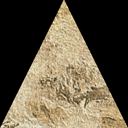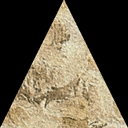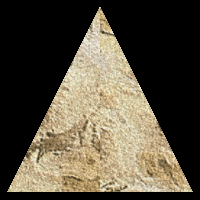DirectX 10 教程25:纹理平移
原文地址:Tutorial 25: Texture Translation(http://www.rastertek.com/dx10tut25.html)。
源代码下载:dx10tut25.zip。
纹理平移是指让纹理沿着多边形表面运动的一种技术。本教程的的代码基于上一个教程。
通过前面教程学习我们知道UV坐标用来将纹理映射到多边形上,UV坐标对应XY坐标,X坐标沿多边形的水平方向,Y坐标沿竖直方向。要实现纹理的平移,我们需要在像素着色器中修改纹理的X、Y坐标,方法很简单:只需在X或Y坐标上加上或减去一个0至1之间的值。
例如我们有下列一个具有纹理的三角形:

如果我们在像素着色器中将纹理坐标X加0.5,就会使纹理移动一半:

框架
框架新添了TranslateShaderClass。

Translate.fx
//////////////////////////////////////////////////////////////////////////////// // Filename: translate.fx //////////////////////////////////////////////////////////////////////////////// ///////////// // GLOBALS // ///////////// matrix worldMatrix; matrix viewMatrix; matrix projectionMatrix; Texture2D shaderTexture;
新添了一个新的float类型的变量textureTranslation,它会在graphicsclass.cpp中的Render方法中进行设置以更新纹理坐标,这个值位于0和1之间。
float textureTranslation;
///////////////////
// SAMPLE STATES //
///////////////////
SamplerState SampleType
{
Filter = MIN_MAG_MIP_LINEAR;
AddressU = Wrap;
AddressV = Wrap;
};
//////////////
// TYPEDEFS //
//////////////
struct VertexInputType
{
float4 position : POSITION;
float2 tex : TEXCOORD0;
};
struct PixelInputType
{
float4 position : SV_POSITION;
float2 tex : TEXCOORD0;
};
////////////////////////////////////////////////////////////////////////////////
// Vertex Shader
////////////////////////////////////////////////////////////////////////////////
PixelInputType TranslateVertexShader(VertexInputType input)
{
PixelInputType output;
// Change the position vector to be 4 units for proper matrix calculations.
input.position.w = 1.0f;
// Calculate the position of the vertex against the world, view, and projection matrices.
output.position = mul(input.position, worldMatrix);
output.position = mul(output.position, viewMatrix);
output.position = mul(output.position, projectionMatrix);
// Store the texture coordinates for the pixel shader.
output.tex = input.tex;
return output;
}
在像素着色器中修改纹理坐标。我们读取纹理坐标,然后在X坐标上增加了translation的大小,这样就会让纹理在多边形上平移了。
////////////////////////////////////////////////////////////////////////////////
// Pixel Shader
////////////////////////////////////////////////////////////////////////////////
float4 TranslatePixelShader(PixelInputType input) : SV_Target
{
// Translate the position where we sample the pixel from.
input.tex.x += textureTranslation;
return shaderTexture.Sample(SampleType, input.tex);
}
////////////////////////////////////////////////////////////////////////////////
// Technique
////////////////////////////////////////////////////////////////////////////////
technique10 TranslateTechnique
{
pass pass0
{
SetVertexShader(CompileShader(vs_4_0, TranslateVertexShader()));
SetPixelShader(CompileShader(ps_4_0, TranslatePixelShader()));
SetGeometryShader(NULL);
}
}
Translateshaderclass.h
TranslateShaderClass是TextureShaderClass的改编版本,只是多了纹理平移的额外功能。
////////////////////////////////////////////////////////////////////////////////
// Filename: translateshaderclass.h
////////////////////////////////////////////////////////////////////////////////
#ifndef _TRANSLATESHADERCLASS_H_
#define _TRANSLATESHADERCLASS_H_
//////////////
// INCLUDES //
//////////////
#include <d3d10.h>
#include <d3dx10.h>
#include <fstream>
using namespace std;
////////////////////////////////////////////////////////////////////////////////
// Class name: TranslateShaderClass
////////////////////////////////////////////////////////////////////////////////
class TranslateShaderClass
{
public:
TranslateShaderClass();
TranslateShaderClass(const TranslateShaderClass&);
~TranslateShaderClass();
bool Initialize(ID3D10Device*, HWND);
void Shutdown();
void Render(ID3D10Device*, int, D3DXMATRIX, D3DXMATRIX, D3DXMATRIX, ID3D10ShaderResourceView*, float);
private:
bool InitializeShader(ID3D10Device*, HWND, WCHAR*);
void ShutdownShader();
void OutputShaderErrorMessage(ID3D10Blob*, HWND, WCHAR*);
void SetShaderParameters(D3DXMATRIX, D3DXMATRIX, D3DXMATRIX, ID3D10ShaderResourceView*, float);
void RenderShader(ID3D10Device*, int);
private:
ID3D10Effect* m_effect;
ID3D10EffectTechnique* m_technique;
ID3D10InputLayout* m_layout;
ID3D10EffectMatrixVariable* m_worldMatrixPtr;
ID3D10EffectMatrixVariable* m_viewMatrixPtr;
ID3D10EffectMatrixVariable* m_projectionMatrixPtr;
ID3D10EffectShaderResourceVariable* m_texturePtr;
新添了指向shader中translation变量的指针。
ID3D10EffectScalarVariable* m_textureTranslationPtr; }; #endif
Translateshaderclass.cpp
////////////////////////////////////////////////////////////////////////////////
// Filename: translateshaderclass.cpp
////////////////////////////////////////////////////////////////////////////////
#include "translateshaderclass.h"
TranslateShaderClass::TranslateShaderClass()
{
m_effect = 0;
m_technique = 0;
m_layout = 0;
m_worldMatrixPtr = 0;
m_viewMatrixPtr = 0;
m_projectionMatrixPtr = 0;
m_texturePtr = 0;
在构造函数中将texture初始化为null。
m_textureTranslationPtr = 0;
}
TranslateShaderClass::TranslateShaderClass(const TranslateShaderClass& other)
{
}
TranslateShaderClass::~TranslateShaderClass()
{
}
bool TranslateShaderClass::Initialize(ID3D10Device* device, HWND hwnd)
{
bool result;
加载translate shader HLSL文件。
// Initialize the shader that will be used to draw the triangles.
result = InitializeShader(device, hwnd, L"../Engine/translate.fx");
if(!result)
{
return false;
}
return true;
}
void TranslateShaderClass::Shutdown()
{
// Shutdown the shader effect.
ShutdownShader();
return;
}
Render方法中的参数translation用来平移纹理,这个变量会被传递到SetShaderParameters方法,设置shader中对应的参数。
void TranslateShaderClass::Render(ID3D10Device* device, int indexCount, D3DXMATRIX worldMatrix, D3DXMATRIX viewMatrix,
D3DXMATRIX projectionMatrix, ID3D10ShaderResourceView* texture, float translation)
{
// Set the shader parameters that it will use for rendering.
SetShaderParameters(worldMatrix, viewMatrix, projectionMatrix, texture, translation);
// Now render the prepared buffers with the shader.
RenderShader(device, indexCount);
return;
}
bool TranslateShaderClass::InitializeShader(ID3D10Device* device, HWND hwnd, WCHAR* filename)
{
HRESULT result;
ID3D10Blob* errorMessage;
D3D10_INPUT_ELEMENT_DESC polygonLayout[2];
unsigned int numElements;
D3D10_PASS_DESC passDesc;
// Initialize the error message.
errorMessage = 0;
// Load the shader in from the file.
result = D3DX10CreateEffectFromFile(filename, NULL, NULL, "fx_4_0", D3D10_SHADER_ENABLE_STRICTNESS, 0,
device, NULL, NULL, &m_effect, &errorMessage, NULL);
if(FAILED(result))
{
// If the shader failed to compile it should have writen something to the error message.
if(errorMessage)
{
OutputShaderErrorMessage(errorMessage, hwnd, filename);
}
// If there was nothing in the error message then it simply could not find the shader file itself.
else
{
MessageBox(hwnd, filename, L"Missing Shader File", MB_OK);
}
return false;
}
Technique名称修改为TranslateTechnique。
// Get a pointer to the technique inside the shader.
m_technique = m_effect->GetTechniqueByName("TranslateTechnique");
if(!m_technique)
{
return false;
}
// Now setup the layout of the data that goes into the shader.
// This setup needs to match the VertexType stucture in the ModelClass and in the shader.
polygonLayout[0].SemanticName = "POSITION";
polygonLayout[0].SemanticIndex = 0;
polygonLayout[0].Format = DXGI_FORMAT_R32G32B32_FLOAT;
polygonLayout[0].InputSlot = 0;
polygonLayout[0].AlignedByteOffset = 0;
polygonLayout[0].InputSlotClass = D3D10_INPUT_PER_VERTEX_DATA;
polygonLayout[0].InstanceDataStepRate = 0;
polygonLayout[1].SemanticName = "TEXCOORD";
polygonLayout[1].SemanticIndex = 0;
polygonLayout[1].Format = DXGI_FORMAT_R32G32_FLOAT;
polygonLayout[1].InputSlot = 0;
polygonLayout[1].AlignedByteOffset = D3D10_APPEND_ALIGNED_ELEMENT;
polygonLayout[1].InputSlotClass = D3D10_INPUT_PER_VERTEX_DATA;
polygonLayout[1].InstanceDataStepRate = 0;
// Get a count of the elements in the layout.
numElements = sizeof(polygonLayout) / sizeof(polygonLayout[0]);
// Get the description of the first pass described in the shader technique.
m_technique->GetPassByIndex(0)->GetDesc(&passDesc);
// Create the input layout.
result = device->CreateInputLayout(polygonLayout, numElements, passDesc.pIAInputSignature, passDesc.IAInputSignatureSize,
&m_layout);
if(FAILED(result))
{
return false;
}
// Get pointers to the three matrices inside the shader so we can update them from this class.
m_worldMatrixPtr = m_effect->GetVariableByName("worldMatrix")->AsMatrix();
m_viewMatrixPtr = m_effect->GetVariableByName("viewMatrix")->AsMatrix();
m_projectionMatrixPtr = m_effect->GetVariableByName("projectionMatrix")->AsMatrix();
// Get pointer to the texture resource inside the shader.
m_texturePtr = m_effect->GetVariableByName("shaderTexture")->AsShaderResource();
获取shader中textureTranslation变量的指针。
// Get a pointer to the texture translation variable inside the shader.
m_textureTranslationPtr = m_effect->GetVariableByName("textureTranslation")->AsScalar();
return true;
}
void TranslateShaderClass::ShutdownShader()
{
// Release the pointer to the translation variable inside the shader.
m_textureTranslationPtr = 0;
// Release the pointer to the texture in the shader file.
m_texturePtr = 0;
// Release the pointers to the matrices inside the shader.
m_worldMatrixPtr = 0;
m_viewMatrixPtr = 0;
m_projectionMatrixPtr = 0;
// Release the pointer to the shader layout.
if(m_layout)
{
m_layout->Release();
m_layout = 0;
}
// Release the pointer to the shader technique.
m_technique = 0;
// Release the pointer to the shader.
if(m_effect)
{
m_effect->Release();
m_effect = 0;
}
return;
}
void TranslateShaderClass::OutputShaderErrorMessage(ID3D10Blob* errorMessage, HWND hwnd, WCHAR* shaderFilename)
{
char* compileErrors;
unsigned long bufferSize, i;
ofstream fout;
// Get a pointer to the error message text buffer.
compileErrors = (char*)(errorMessage->GetBufferPointer());
// Get the length of the message.
bufferSize = errorMessage->GetBufferSize();
// Open a file to write the error message to.
fout.open("shader-error.txt");
// Write out the error message.
for(i=0; i<bufferSize; i++)
{
fout << compileErrors[i];
}
// Close the file.
fout.close();
// Release the error message.
errorMessage->Release();
errorMessage = 0;
// Pop a message up on the screen to notify the user to check the text file for compile errors.
MessageBox(hwnd, L"Error compiling shader. Check shader-error.txt for message.", shaderFilename, MB_OK);
return;
}
void TranslateShaderClass::SetShaderParameters(D3DXMATRIX worldMatrix, D3DXMATRIX viewMatrix, D3DXMATRIX projectionMatrix,
ID3D10ShaderResourceView* texture, float translation)
{
// Set the world matrix variable inside the shader.
m_worldMatrixPtr->SetMatrix((float*)&worldMatrix);
// Set the view matrix variable inside the shader.
m_viewMatrixPtr->SetMatrix((float*)&viewMatrix);
// Set the projection matrix variable inside the shader.
m_projectionMatrixPtr->SetMatrix((float*)&projectionMatrix);
使用SetFloat方法将translation值设置到shader中。
// Bind the texture.
m_texturePtr->SetResource(texture);
// Set the texture translation variable inside the shader.
m_textureTranslationPtr->SetFloat(translation);
return;
}
void TranslateShaderClass::RenderShader(ID3D10Device* device, int indexCount)
{
D3D10_TECHNIQUE_DESC techniqueDesc;
unsigned int i;
// Set the input layout.
device->IASetInputLayout(m_layout);
// Get the description structure of the technique from inside the shader so it can be used for rendering.
m_technique->GetDesc(&techniqueDesc);
// Go through each pass in the technique (should be just one currently) and render the triangles.
for(i=0; i<techniqueDesc.Passes; ++i)
{
m_technique->GetPassByIndex(i)->Apply(0);
device->DrawIndexed(indexCount, 0, 0);
}
return;
}
Graphicsclass.h
////////////////////////////////////////////////////////////////////////////////
// Filename: graphicsclass.h
////////////////////////////////////////////////////////////////////////////////
#ifndef _GRAPHICSCLASS_H_
#define _GRAPHICSCLASS_H_
/////////////
// GLOBALS //
/////////////
const bool FULL_SCREEN = true;
const bool VSYNC_ENABLED = true;
const float SCREEN_DEPTH = 1000.0f;
const float SCREEN_NEAR = 0.1f;
///////////////////////
// MY CLASS INCLUDES //
///////////////////////
#include "d3dclass.h"
#include "cameraclass.h"
#include "modelclass.h"
#include "translateshaderclass.h"
////////////////////////////////////////////////////////////////////////////////
// Class name: GraphicsClass
////////////////////////////////////////////////////////////////////////////////
class GraphicsClass
{
public:
GraphicsClass();
GraphicsClass(const GraphicsClass&);
~GraphicsClass();
bool Initialize(int, int, HWND);
void Shutdown();
bool Frame();
bool Render();
private:
D3DClass* m_D3D;
CameraClass* m_Camera;
ModelClass* m_Model;
新添了TranslateShaderClass对象。
TranslateShaderClass* m_TranslateShader; }; #endif
Graphicsclass.cpp
下面的代码只包含与上一个教程不同的部分。
////////////////////////////////////////////////////////////////////////////////
// Filename: graphicsclass.cpp
////////////////////////////////////////////////////////////////////////////////
#include "graphicsclass.h"
GraphicsClass::GraphicsClass()
{
m_D3D = 0;
m_Camera = 0;
m_Model = 0;
在构造函数中将TranslateShaderClass对象设置为null。
m_TranslateShader = 0;
}
GraphicsClass::GraphicsClass(const GraphicsClass& other)
{
}
GraphicsClass::~GraphicsClass()
{
}
bool GraphicsClass::Initialize(int screenWidth, int screenHeight, HWND hwnd)
{
bool result;
// Create the Direct3D object.
m_D3D = new D3DClass;
if(!m_D3D)
{
return false;
}
// Initialize the Direct3D object.
result = m_D3D->Initialize(screenWidth, screenHeight, VSYNC_ENABLED, hwnd, FULL_SCREEN, SCREEN_DEPTH, SCREEN_NEAR);
if(!result)
{
MessageBox(hwnd, L"Could not initialize Direct3D.", L"Error", MB_OK);
return false;
}
// Create the camera object.
m_Camera = new CameraClass;
if(!m_Camera)
{
return false;
}
// Create the model object.
m_Model = new ModelClass;
if(!m_Model)
{
return false;
}
// Initialize the model object.
result = m_Model->Initialize(m_D3D->GetDevice(), L"../Engine/data/seafloor.dds", "../Engine/data/triangle.txt");
if(!result)
{
MessageBox(hwnd, L"Could not initialize the model object.", L"Error", MB_OK);
return false;
}
创建并初始化TranslateShaderClass对象。
// Create the translate shader object.
m_TranslateShader = new TranslateShaderClass;
if(!m_TranslateShader)
{
return false;
}
// Initialize the translate shader object.
result = m_TranslateShader->Initialize(m_D3D->GetDevice(), hwnd);
if(!result)
{
MessageBox(hwnd, L"Could not initialize the translate shader object.", L"Error", MB_OK);
return false;
}
return true;
}
void GraphicsClass::Shutdown()
{
// Release the translate shader object.
if(m_TranslateShader)
{
m_TranslateShader->Shutdown();
delete m_TranslateShader;
m_TranslateShader = 0;
}
// Release the model object.
if(m_Model)
{
m_Model->Shutdown();
delete m_Model;
m_Model = 0;
}
// Release the camera object.
if(m_Camera)
{
delete m_Camera;
m_Camera = 0;
}
// Release the Direct3D object.
if(m_D3D)
{
m_D3D->Shutdown();
delete m_D3D;
m_D3D = 0;
}
return;
}
bool GraphicsClass::Frame()
{
// Set the position of the camera.
m_Camera->SetPosition(0.0f, 0.0f, -10.0f);
return true;
}
bool GraphicsClass::Render()
{
D3DXMATRIX worldMatrix, viewMatrix, projectionMatrix;
static float textureTranslation = 0.0f;
将translation的值每帧增加0.01,如果超过1则重新设置为0。
// Increment the texture translation position.
textureTranslation += 0.01f;
if(textureTranslation > 1.0f)
{
textureTranslation -= 1.0f;
}
// Clear the scene to the color of the fog.
m_D3D->BeginScene(0.0f, 0.0f, 0.0f, 1.0f);
// Generate the view matrix based on the camera's position.
m_Camera->Render();
// Get the world, view, and projection matrices from the camera and d3d objects.
m_D3D->GetWorldMatrix(worldMatrix);
m_Camera->GetViewMatrix(viewMatrix);
m_D3D->GetProjectionMatrix(projectionMatrix);
// Put the model vertex and index buffers on the graphics pipeline to prepare them for drawing.
m_Model->Render(m_D3D->GetDevice());
// Render the model using the translate shader.
m_TranslateShader->Render(m_D3D->GetDevice(), m_Model->GetIndexCount(), worldMatrix, viewMatrix, projectionMatrix,
m_Model->GetTexture(), textureTranslation);
// Present the rendered scene to the screen.
m_D3D->EndScene();
return true;
}
总结
使用一个简单的像素着色器就可以实现一个非常有用的效果,通过使用一些简单的数学知识我们就可以创建许多不同的效果,也可以在表面上对不同的纹理施加动画模拟运动的效果。

练习
1.编译并运行程序,你会看到纹理会在多边形表面上移动。
2.在像素着色器中将沿X轴平移修改为沿Y轴平移。
3.在像素着色器中设置同时沿X和Y轴平移。
文件下载(已下载 938 次)发布时间:2012/8/12 下午9:53:13 阅读次数:8149
